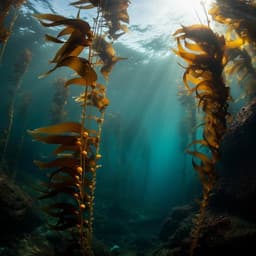
Environmental Studies and Forestry
Habitat compression and ecosystem shifts as potential links between marine heatwave and record whale entanglements
J. A. Santora, N. J. Mantua, et al.
This captivating study explores the intricate links between the northeast Pacific marine heatwave of 2014-2016 and the alarming rise in whale entanglements in California's crab fishery. The research led by a team including Jarrod A. Santora and Nathan J. Mantua unveils significant ecosystem changes and proposes innovative strategies for climate-ready fisheries to mitigate future risks.
~3 min • Beginner • English
Introduction
Marine heatwaves (MHWs) are increasing in frequency, duration, and spatial extent, creating new challenges for managing marine ecosystems and protected species. The California Current Large Marine Ecosystem (CCLME) is a wind-driven upwelling system where cool, nutrient-rich waters support diverse food webs and valuable fisheries. The 2014–2016 North Pacific MHW caused unprecedented multi-year warming, toxic Pseudo-nitzschia blooms with persistent domoic acid, shifts in pelagic biodiversity, and a historic delay in the California Dungeness crab fishery opening. Concurrently, reported whale entanglements—predominantly humpback whales—rose sharply, especially off California, raising concerns about ecosystem changes and fishery interactions. The authors hypothesize that onshore compression of the upwelling habitat during the MHW reduced the offshore cool-water domain, altered prey availability (declining krill, increasing anchovy nearshore), and drove a shoreward shift and prey-switching by humpback whales, increasing spatial overlap with fixed-gear fisheries. The delayed 2015–2016 crab season further intensified overlap by aligning peak gear deployment with peak whale arrival. The study assesses this hypothesis by synthesizing ocean model outputs (a Habitat Compression Index, HCI), long-term ecosystem survey data on forage species and whale occurrence, confirmed whale entanglement records, and crab fishery landings data. It also frames a management response via risk assessment and dynamic ocean management.
Literature Review
Methodology
Study region and period: Central California Current, focusing on conditions preceding and during the 2014–2016 marine heatwave (MHW). Data sources and analyses included:
- Habitat Compression Index (HCI): Monthly 2 m sea surface temperature (SST) fields from a data-assimilative ROMS 4D-Var oceanographic reanalysis (0.1° grid, 42 σ-levels) maintained by UC Santa Cruz, spanning 1980–2016. Cool upwelling habitat was defined as area with SST ≤12 °C. For each month, the number of model grid cells ≤12 °C between 35.5–40°N provided an areal index; periods were categorized as cool expansion (>+1 SD), limited cool habitat (<−1 SD), and habitat compression (between mean and −1 SD). An offshore–onshore temperature gradient metric was also computed by averaging SST in onshore (0–50 km) and offshore (50–150 km) coastal bands per 0.1° latitude for March–May, subtracting onshore from offshore temperatures (larger positive values indicate stronger coastal coolness relative to offshore warmth). Time series were examined for trends and autocorrelation.
- Whale entanglement data: Confirmed large whale entanglement records compiled by NOAA Fisheries West Coast Region (1982–2017), including species identification when possible and fishing gear type when identified. Monthly summaries were used to assess seasonal/annual changes. Noted caveats: reported sighting location may differ from entanglement location; gear-type attribution often uncertain.
- Ecosystem surveys (RREAS): NOAA-NMFS Rockfish Recruitment and Ecosystem Assessment Survey (RREAS) conducted late April–mid-June annually since 1983 (standardized species enumeration since 1990). Night mid-water trawls (modified Cobb trawl, 9.5 mm cod-end, 15 min at 30 m headrope) at fixed stations provided catch-per-unit-effort (CPUE) for micronekton, including northern anchovy (adult and YOY) and total euphausiids (krill). Standardized anomalies (relative to 1990–2016) were computed for central California (36–38°N). Daytime multi-frequency echosounder (Simrad EK-60) data quantified krill abundance and distribution via Nautical Area Scattering Coefficient (NASC, m² nmi⁻²), aggregated to a 25 km² grid; spatial aggregation intensity assessed using two-dimensional Moran’s I. Visual line-transect surveys recorded marine mammals; humpback whale relative abundance was partitioned on-shelf (<200 m) vs. off-shelf (>200 m) with Mann–Whitney U-tests to test for distribution shifts by year (2001–2016; no survey in 2011).
- Crab fishery data: California Dungeness crab commercial landings (metric tons) and fish ticket counts by month from the Pacific Fisheries Information Network (PacFIN; 1990–2015 long-term mean vs. 2016 delayed season). These data characterized seasonal fishing intensity and its alignment with humpback whale migratory presence.
- Ancillary observations: During 2016 RREAS, high densities of crab gear were mapped visually to avoid trawl conflicts; at least 12 of 137 planned trawls were canceled due to dense gear fields (unprecedented for the survey). Note: there is no mandatory gear-location logging; aerial surveys would provide broader coverage but were not consistently available.
Key Findings
- Upwelling habitat compression: The HCI showed markedly reduced area of cool SST (≤12 °C) during the MHW, with near absence of cool habitat in March 2015–2016 and coastal confinement in May 2014–2016. Offshore–onshore SST gradients indicated unprecedented along-coast compression of cold water both north of 38°N and south of 36°N during 2014–2016, limiting upwelling habitat to nearshore. No long-term trend in HCI (p > 0.05), but significant autocorrelation at 1-year lag.
- Forage community shifts: Epipelagic species richness reached record highs in 2015 due to warm-affinity species presence, indicating an anomalous ecosystem state. Krill abundance, strongly positive in 2008–2014, dropped anomalously low in 2015 (especially on-shelf) and was average in 2016. Adult anchovy anomalies remained negative 2008–2016, while YOY anchovy anomalies peaked in 2015–2016 (highest on record in central California time series). Spatially, krill hotspots declined in abundance and clustering in 2014–2016; anchovy catches became highly clustered coastwide in 2015 and extremely concentrated nearshore in 2016 (e.g., Monterey Bay, Point Conception).
- Whale distribution and prey-switching: Humpback whales exhibited a significant shift from offshore concentration in 2014 to onshore concentration in 2015–2016 (p < 0.01), consistent with reduced krill availability along the shelf break and increased nearshore anchovy concentrations. This suggests prey-switching from krill to anchovy and shoreward redistribution, increasing overlap with fixed-gear fisheries.
- Entanglement surge: Confirmed whale entanglements (predominantly humpbacks) increased sharply beginning in 2014, remained high in 2015 and 2016, and occurred in all months during the MHW. Coastwide confirmed entanglements on the US West Coast increased 400% to a historic high of 50 in 2015 from a pre-2014 average of about 10 per year. Where gear was identified, most humpback entanglements involved pot gear, with about 70% attributed to the commercial Dungeness crab fishery. Many reports were in central California (e.g., Monterey Bay), though entanglement locations can be distant from origin.
- Fishery overlap intensification: The unprecedented delay of the 2015–2016 Dungeness crab season (due to domoic acid) shifted peak fishing effort into April–May, coinciding with peak humpback arrival and high nearshore whale densities, producing gear–whale overlap not previously observed. RREAS encountered unprecedented densities of crab gear in April–June 2016, necessitating gear mapping and cancellation of 12 trawls.
- Management implications: Findings support that MHW-driven upwelling habitat compression, altered forage distributions, and prey-switching, combined with recovering whale populations and the delayed crab season, amplified gear–whale overlap and entanglements. The study proposes using HCI and ecosystem indicators in seasonal risk assessments and dynamic ocean management (e.g., California’s RAMP) to mitigate entanglement risk while supporting fisheries.
Discussion
The study addresses how climate extremes, specifically the 2014–2016 MHW, can restructure the CCLME in ways that elevate whale entanglement risk. Habitat compression reduced offshore cool-water upwelling habitat, altering prey fields: krill declined and became less aggregated, while anchovy increased nearshore and became highly clustered. Humpback whales, flexible foragers, responded by shifting shoreward and switching prey to anchovy, increasing their presence within the primary footprint of the Dungeness crab fishery and its vertical lines. The delayed 2015–2016 crab season further synchronized high gear densities with peak whale arrival, intensifying overlap. Temporal patterns of entanglements (rising from 2014, high through 2016) indicate that ecosystem changes, not solely the delayed season, contributed to elevated risk. While correlational, convergent lines of evidence from HCI, forage mapping, whale distribution, and fishery activity support the proposed mechanism. The findings highlight the need for climate-ready fisheries approaches: integrating ecosystem indicators (e.g., HCI, forage distributions, whale concentrations, entanglement reports) into seasonal, spatially explicit risk assessments; deploying dynamic ocean management tools; and improving gear technology (e.g., weak links, gear tracking, ropeless systems) to reduce interactions. Collaborative governance, exemplified by California’s Whale Entanglement Working Group and the Risk Assessment and Mitigation Program (RAMP), can operationalize these insights to balance conservation and fishery livelihoods in a changing climate.
Conclusion
This work links the 2014–2016 marine heatwave to record whale entanglements via upwelling habitat compression, forage redistribution, and a shoreward shift and prey-switching of humpback whales that increased overlap with fixed-gear fisheries. The delayed Dungeness crab season in 2015–2016 coincided with peak whale presence, further elevating risk. The study introduces a Habitat Compression Index and demonstrates the value of integrating oceanographic, ecological, and fishery data for retrospective and prospective risk assessments. It supports climate-ready fisheries management through dynamic ocean tools and collaborative frameworks (e.g., RAMP) to mitigate entanglements while sustaining fishing communities. Future research should: integrate multiple standardized surveys and satellite-derived seascape metrics to refine spatially explicit indicators; forecast climate-driven shifts in forage and predator distributions; evaluate thresholds in prey availability relevant to whale behavior; and test gear innovations and temporal–spatial fishery strategies to reduce risk.
Limitations
- Causality is inferred from covarying indicators; direct causal links between habitat compression, prey shifts, whale behavior, and entanglements are not experimentally confirmed.
- Entanglement sighting locations may not reflect the true location of entanglement; whales can carry gear long distances, complicating spatial attribution.
- Gear type is often unidentified; attribution to specific fisheries is incomplete.
- Whale visual survey coverage is seasonal (late spring/early summer) with one missing year (2011) and subject to sea-state/visibility constraints; fine-scale behavior and movement data were not available.
- Fishery gear location data are not mandatory/reported systematically; 2016 gear mapping was ad hoc and limited; aerial surveys were not consistently available.
- HCI is a relative, SST-based proxy for upwelling habitat; it does not directly measure nutrients or productivity and showed no long-term trend, though compression patterns were pronounced during the MHW.
- Analyses focus on central California; generalization to the entire CCLME or other systems requires caution.
Related Publications
Explore these studies to deepen your understanding of the subject.







